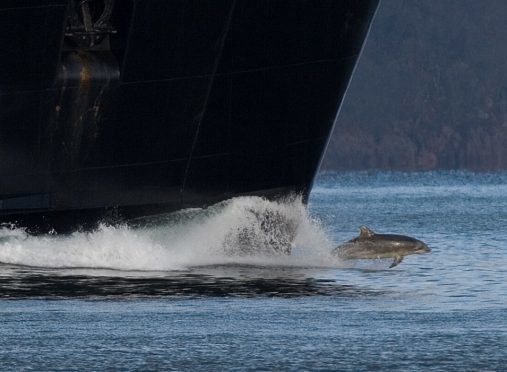A wildlife group is appealing for help in tracing a famous dolphin which has gone missing since it visited the north of Scotland.
Clet has become known across the UK and Europe for travelling alone and following fishing boats.
In December 2014, the creature was captured on camera off the coast of the Isle of Mull.
Wildlife photographer Nic Davies spotted the well-travelled animal near to the shore of Craignure.
The boat-loving bottlenose, who has distinctive scarring on the dorsal fin, was captured on camera following a ferry between Oban and Mull.
But there has now not been a recorded sighting since August and marine wildlife charity, the Sea Watch Foundation, is hoping to track the dolphin down.
Together with the Cornwall Wildlife Trust (CWT), the organisation has created an interactive map tracking Clet’s incredible journey.
The mammal was first given its name by locals in Cap Sizun, Brittany, where it was regularly spotted by fishermen from 2008 to 2010.
In 2011, the swimmer made the trip across the Channel and visited the Cornwall and Devon coastlines its home for the next three years.
Shortly afterwards, Clet popped up close to the Republic of Ireland coastline. And there were a number of incidents where Clet arrived in various harbours.
The celebrity seafarer subsequently left the Emerald Isle and made the trip to this country’s shores, initally at Corran, near Fort William before moving on to Glenuig, Lochailort.
Soon afterwards, Clet was witnessed bow-riding, a phenomenon where dolphins surf the waves which form at the front of a moving vessel, in the Inner Hebrides.
The last sighting of the creature was in the waters near Portland, in Dorset.
The foundation is urging anyone who recognises Clet to get in touch with Niki Clear at CWT by e-mailing niki.clear@cornwallwildlifetrust.org.uk.
Clet swimming amongst sailing boats off Portland in July 2015 (Picture: Andrew Simpson)Clet interacting with Dusty off Inisheer, Republic of Ireland, in 2014. (Picture: : Cormac Coyne, The Irish Whale and Dolphin Group)Clet captured in 2015 showcasing his distinctive missing chunk on his dorsal fin. (Picture: Friends of Fowley Estuary)
